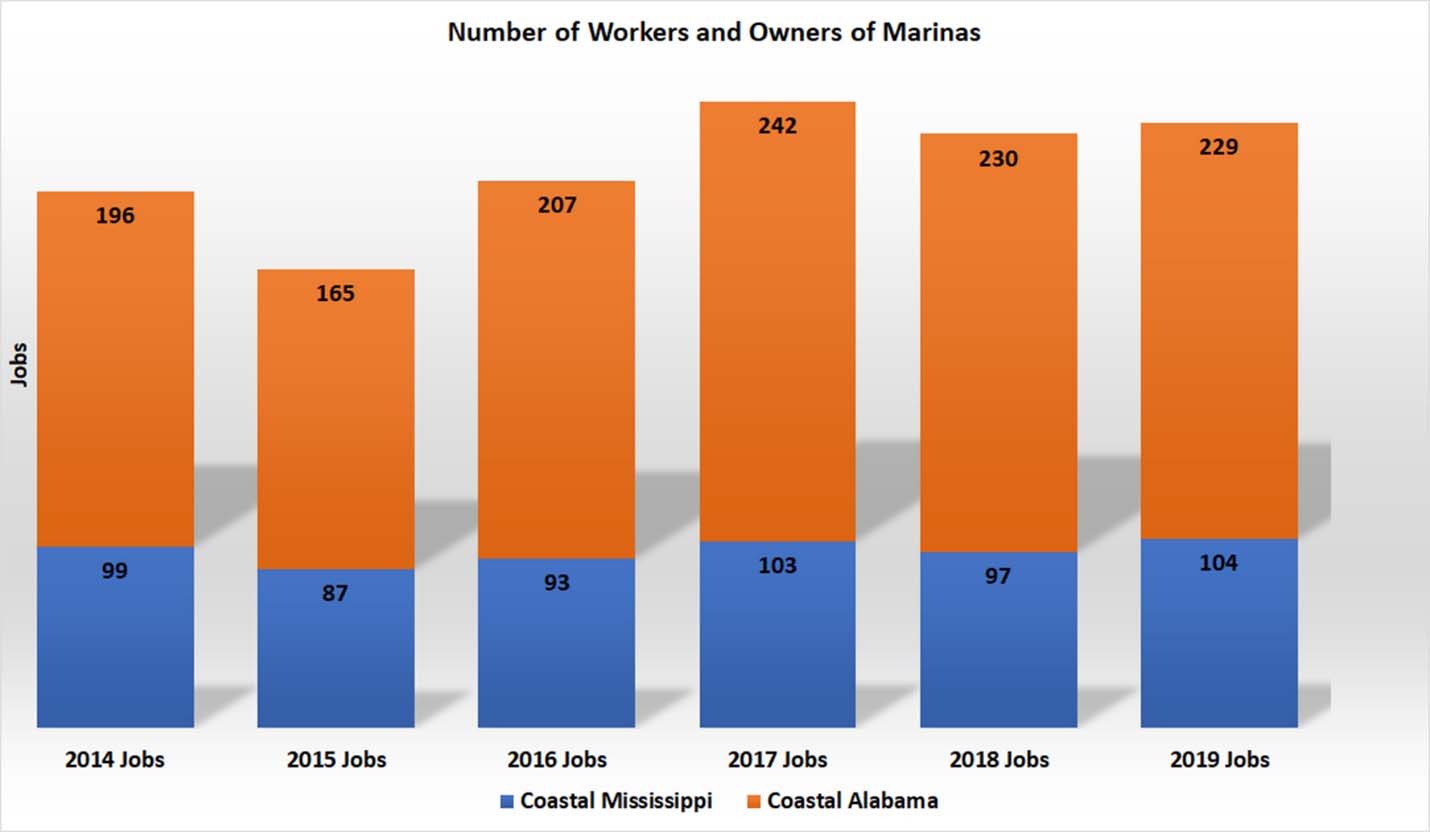Vol. 10 No. 3 / Commercial Marinas in Mississippi and Alabama Gulf Coasts
Economic Contribution of Commercial Marinas in Mississippi and Alabama Gulf Coasts
Abstract
In this issue, Dr. Posadas describes the economic contribution of commercial marinas in Coastal Mississippi and Alabama counties. Coastal Mississippi consists of three counties, namely: Hancock, Harrison, and Jackson Counties, while Coastal Alabama includes Baldwin and Mobile Counties. The commercial marinas contributed $3.81 million and $10.95 million to the gross regional products of Coastal Mississippi and Alabama regions, respectively. Businesses were adversely affected by the lingering impacts of the man-made disaster associated with the prolonged and twice opening of the Bonnet Carre spillway from February to April and May to July 2019. The long-term economic impacts of the man-made disaster to these marinas will take some time to assess. Instead, some benchmark data about these businesses during the past five years are presented.
Employment and Wages, Salaries, and Earnings
Commercial marinas are represented by NAICS Code 713930 (Marinas). This industry “comprises of establishments, commonly known as marinas, engaged in operating docking and/or storage facilities for pleasure craft owners, with or without one or more related activities, such as retailing fuel and marine supplies; and repairing, maintaining, or renting pleasure boats” (NAICS, 2020).
The industry employed an average 97 workers and owners of commercial marinas in the three Coastal Mississippi Counties from 2014 to 2018. However, the number of jobs created by the industry increased to 104 jobs in 2019 (Fig. 1). In Coastal Alabama Counties, the number of jobs in the industry averaged 211 persons from 2014 to 2018 as compared to the 229 jobs in 2019.

proprietors. U.S. Bureau of Labor Statistics, Quarterly Census of Employment and Wages (EMSI, 2020).
The combined wages, salaries, and proprietor earnings of all the QCEW employees, non-QCEW employees, self-employed, and extended proprietors in the three Coastal Mississippi Counties increased from $22,481 in 2014 to $25,838 in 2018 (Fig. 2). Lower combined wages, salaries, and proprietor earnings were observed in Coastal Mississippi, averaging $25,090 per year during the past five years as compared to Coastal Alabama.
In Coastal Alabama, the combined wages, salaries, and proprietor earnings of all the QCEW employees, non-QCEW employees, self-employed, and extended proprietors in the two coastal counties increased from $31,341 in 2014 to $34,506 in 2018. On average, the five-year combined earnings in the industry averaged $32,315 per person.

proprietors. U.S. Bureau of Labor Statistics, Quarterly Census of Employment and Wages (EMSI, 2020).
Distribution of Workers by Gender
The 2020 industrial overview released by EMSI (2020) showed that among workers and owners in the three Coastal Mississippi Counties, 53.5 percent were male. About 46.5 percent of the workers and owners were female. In Coastal Alabama, a similar distribution of workers and owners by gender was reported, 52.1 percent were males and 47.9 percent were females. (Table 1).
| Gender | 2019 Jobs | 2019 Percent |
|---|---|---|
| Males | 56 | 53.5% |
| Females | 48 | 46.5% |
| Total | 104 | 100.0% |
| Gender | 2019 Jobs | 2019 Percent |
|---|---|---|
| Males | 119 | 52.1% |
| Females | 110 | 47.9% |
| Total | 229 | 100.0% |
Distribution of Workers by Age
The recently industrial overview released by EMSI (2020) showed that workers and owners in the three Coastal Mississippi Counties averaged 36 years old (Table 2). Bout 5.9 percent of the workers and owners are 65 years old and above. The 55-64 years old consist of 10.3 percent. The 45-54 years old workers and owners added 14.7 percent of the total. Approximately 15.8 percent belonged to the 35-44 years old age group. More than 53 percent of the workers and owners are below 35 years old.
In Coastal Alabama, the workers and owners averaged 37 years old. Around than 8.1 percent of the workers and owners are 65 years old and above. About 10.5 percent belonged to the 55-64 years old age group. The 45-54 age group comprised of 14 percent. The 35-44 age group added 16.4 percent. The younger age group below 35 years old comprised 51 percent.
| Age | 2019 Jobs | 2019 Percent |
|---|---|---|
| 14-18 | 13 | 12.9% |
| 19-24 | 19 | 18.6% |
| 25-34 | 23 | 21.7% |
| 35-44 | 16 | 15.8% |
| 45-54 | 15 | 14.7% |
| 55-64 | 11 | 10.3% |
| 65+ | 6 | 5.9% |
| Total | 104 | 100% |
| Average Age (yr) | 36 |
| Age | 2019 Jobs | 2019 Percent |
|---|---|---|
| 14-18 | 27 | 11.9% |
| 19-24 | 38 | 16.7% |
| 25-34 | 51 | 22.4% |
| 35-44 | 38 | 16.4% |
| 45-54 | 32 | 14.0% |
| 55-64 | 24 | 10.5% |
| 65+ | 19 | 8.1% |
| Total | 229 | 100% |
| Average Age (yr) | 37 |
Distribution of Workers by Race or Ethnicity
The newly released industrial overview (EMSI, 2020) also categorized workers and owners by race or ethnicity (Table 3). About 81.9 percent of the workers and owners in Coastal Mississippi are White, followed by Black or African American (12.3%). The remaining workers and owners are Hispanic or Latino (4%), two or more races (1%), and Asian (0.8%).
In Coastal Alabama, 83.4 percent of the workers and owners are White. Black or African American consisted of 10.8 percent. The rest consisted of Hispanic or Latino (3.3%), two or more races (1.3%), and Asian (1.2%).
| Race/Ethnicity | 2019 Jobs | 2019 Percent |
|---|---|---|
| White | 85 | 81.9% |
| Black or African American | 13 | 12.3% |
| Hispanic or Latino | 4 | 4.0% |
| Two or More Races | 1 | 1.0% |
| Asian | 1 | 0.8% |
| American Indian or Alaska Native | 0 | 0.0% |
| Native Hawaiin or Other Pacific Islander | 0 | 0.0% |
| Total | 104 | 100.0% |
| Race/Ethnicity | 2019 Jobs | 2019 Percent |
|---|---|---|
| White | 191 | 83.4% |
| Black or African American | 25 | 10.8% |
| Hispanic or Latino | 8 | 3.3% |
| Two or More Races | 3 | 1.3% |
| Asian | 3 | 1.2% |
| American Indian or Alaska Native | 0 | 0.0% |
| Native Hawaiin or Other Pacific Islander | 0 | 0.0% |
| Total | 229 | 100.0% |
Seafood Businesses Registered in MarketMaker
If you need an online database of local fishing, fishfarming and seafood-related businesses and charter-boat operations, you may use the search tool in Mississippi MarketMaker or other state MarketMaker programs. Also, in MarketMaker you can see active listings of of buy and sell forums for buyers, sellers, products and more.
There are no commercial marinas in the United States which registered their business profiles in MarketMaker. The Mississippi Department of Marine Resources (MDMR) promotes the participation of Mississippi marinas in the Clean and Resilient Marina Initiative (MDMR, 2020). The Mississippi-Alabama Sea Grant Consortium (MASGC, 2020) assists marina, boatyard, and yacht club operators through its Clean Marina Program.
Gross Regional Product
The estimated total sales of commercial marinas businesses in the coastal counties in Mississippi and Alabama reached $28.72 million in 2019. Data retrieved from EMSI (2020) indicated that the industry sold $7.41 million in the three Coastal Mississippi counties in 2019. In the two coastal counties in Alabama, the commercial Marinas industry report total sales amounting to $21.30 million in 2019.
The Bureau of Economic Analysis (2019) defines the gross domestic product (GDP) as the value of the goods and services produced in the United States. The gross regional product (GRP) is simply the GDP for the region of study. EMSI (2020) measures the GRP as the sum of total industry earnings, taxes on production and imports, and profits, less subsidies.
The gross regional product (GRP) in the three coastal Mississippi counties generated by commercial marinas was estimated at $3.81 million in 2019 (EMSI, 2020). The bulk of the GRP consisted of earnings (79%), followed by property income (4.5%), and taxes (16.5%).
The GRP in the two coastal Alabama counties produced by commercial marinas was calculated at $10.95 million in 2019 (EMSI, 2020). Most of the GRP consisted of earnings (81.3%), followed by property income (5.2%), and taxes (13.5%).
The combined gross regional products (GRP) in the five coastal Mississippi and Alabama counties reached $14.77 million in 2019. The combined GRP represents about 51.4 percent of the combined total sales of the commercial marinas in the coastal regions in Mississippi and Alabama.
Disaster Implications
To save lives, properties, and the way of life in New Orleans and surrounding communities, the Bonnet Carre spillway was opened to release floodwater into Lake Pontchartrain and eventually into the Mississippi Sound. The livelihoods and way of life of the fishing and seafood-related businesses and surrounding communities dependent on coastal tourism and the local seafood industry are threatened by lingering effects of the man-made disaster associated with the prolonged and twice opening of the Bonnet Carre spillway since February to April and May to July 2019.
The massive volumes of freshwater which were dumped into the fertile fishery grounds of the Mississippi Sound brought with them harmful freshwater algae that bloomed all over the coast. Beaches were closed, and advisories were in place until Labor Day weekend. Massive losses in vital marine resources in Coastal Mississippi disrupted commercial and recreational fishing activities.
This man-made disaster is a negative externality that causes consumer and producer losses. Market forces cannot create a system of payments for the offended parties. The government needs to intervene and compensate for the losses suffered by consumers and producers. The effects of the disaster confronting the Mississippi Sound will linger for some time, and the economic hardships will further erode the quality of life of coastal households, businesses, and communities.
Citation
Posadas, Benedict C. Economic Contribution of Commercial Marinas in Mississippi and Alabama Gulf Coasts. Mississippi MarketMaker Newsletter, Vol. 10, No. 3. March 12, 2020. http://extension.msstate.edu/newsletters/mississippi-marketmaker.







